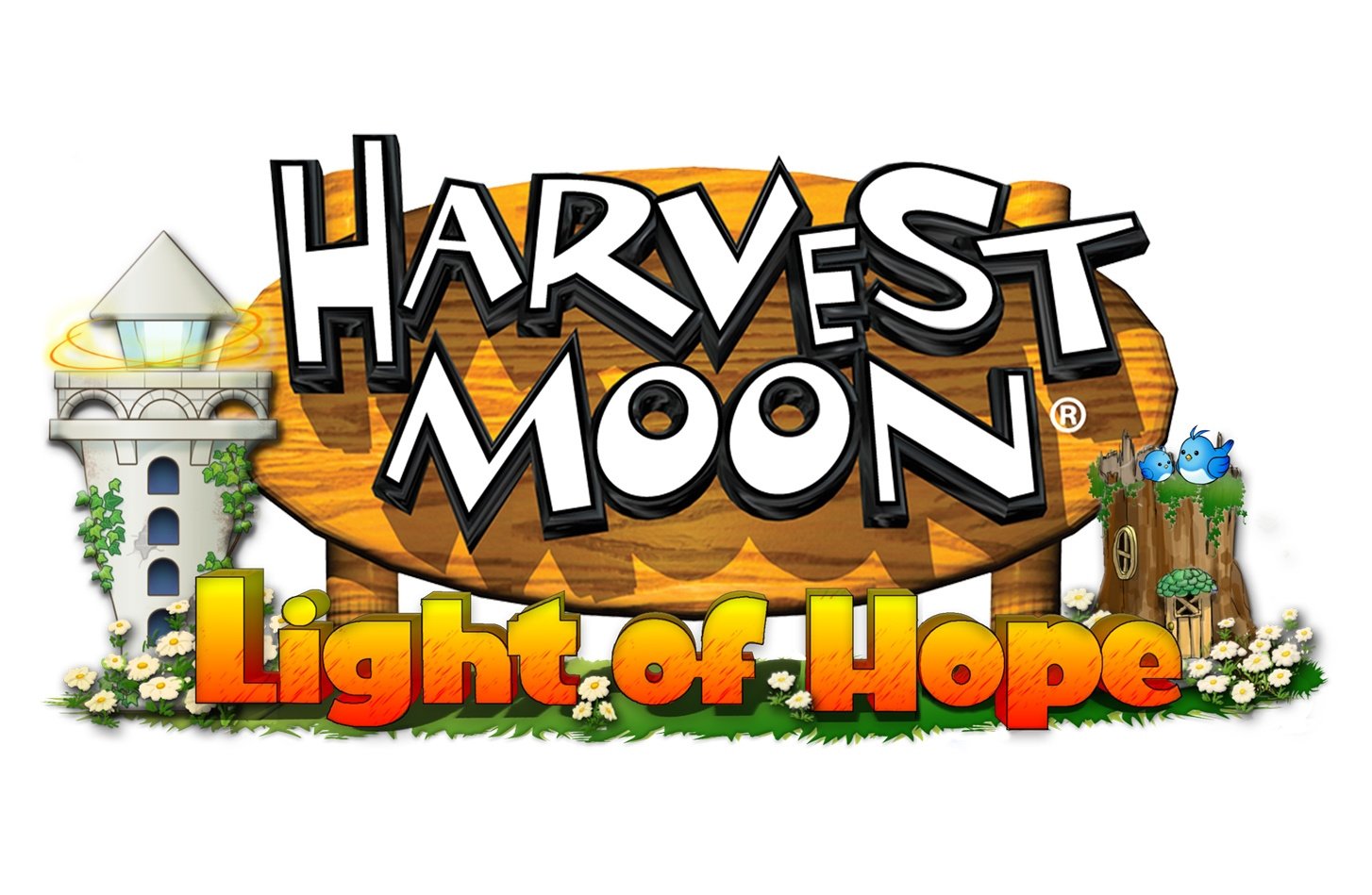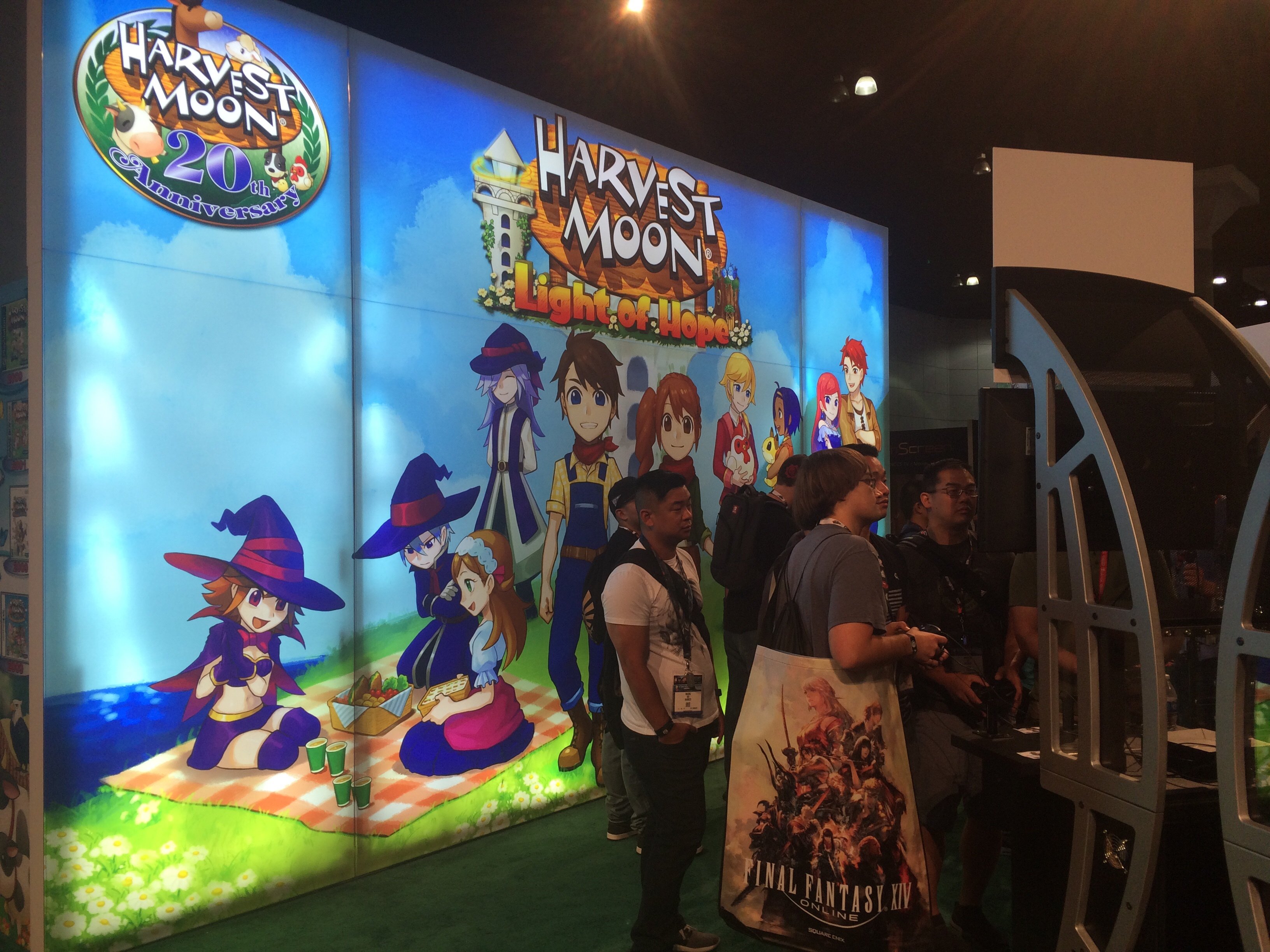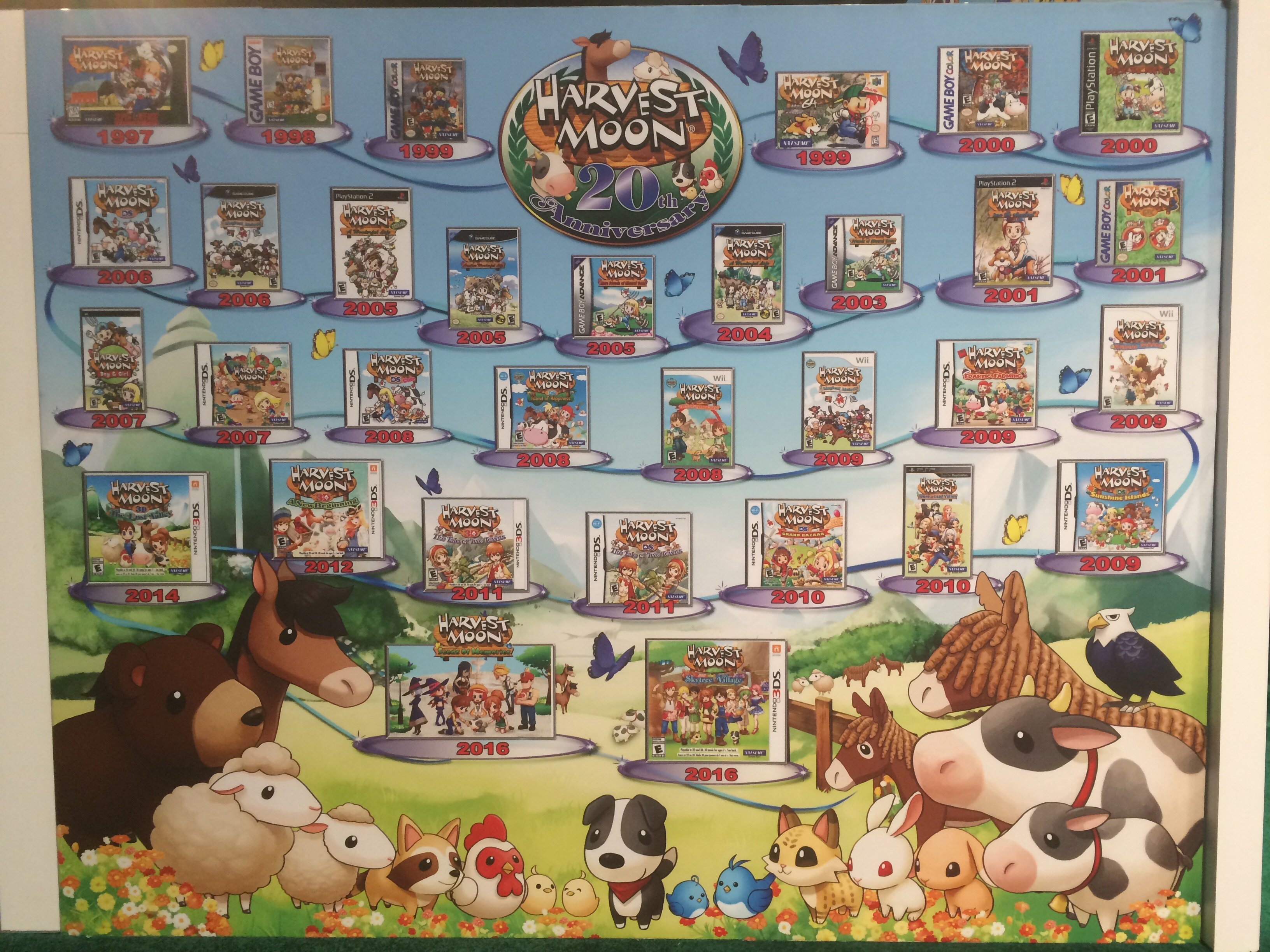
Natsume’s booth at this year’s E3 was a farmland oasis from the wider chaos of the showfloor, decked out in pastoral charm and filled with flowers and plenty of plush cows, chickens, and sheep. It’s a familiar scene, but it seemed particularly pleasant this year, and the cause of the celebration was clear: it’s Harvest Moon’s 20th anniversary, and Natsume’s planted the seeds of a brand new entry in Harvest Moon: Light of Hope.
The latest in the lineage of Natsume’s in-house Harvest Moons — as distinct from the Story of Seasons games localized under the same name prior to 2014 — Light of Hope is also the first of these farming sims to come to the Switch. We were able to take a tour around the ranch, playing a development build in handheld mode, and we’re happy to say the future looks bright — Light of Hope looks set to marry a thoughtful new visual style and streamlined controls with the back-to-basics farming and flirting that made the series such a hit from the start.
Subscribe to Nintendo Life on YouTube841k
Light of Hope puts players in the role of a young girl or boy who sets sail to start a new life, and promptly ends up shipwrecked by a wayward monsoon. All’s not lost, however, and once you wake up you’ll find you’ve been saved by the local islanders — or the few of them that haven’t left the isle for better pastures, anyway. From that rocky start, your goal for the game will be to revitalize the town and its legendary lighthouse through the powers of farming, hard work, and true love.

Though the build we played was still early in development, we were able to see a bit of how this will play out. By completing basic Harvest Moon tasks like clearing the land, growing crops, shipping produce, and raising animals, you’ll be able to entice more villagers to return to the island; once you bring back villagers, you’ll be able to help them out with requests and take advantage of more goods, services, and features that will open up further possibilities for farming. It’s a classic cycle, and reflects the type of satisfyingly circular progression that Harvest Moon is famous for.
That’s not the only area in which this new entry heads back to the series’ roots, either. Breaking with the 3D engines of Natsume’s previous home-grown Harvest Moons like The Lost Valley and Skytree Village on 3DS, Light of Hope is a top-down affair, and that’s a design decision motivated by a specific goal: returning to the feel of the Super Nintendo original. It’s a style that Natsume has referred to as ‘retro plus’ — not pixel art, but also not the super-slick lines of AAA 2D; rather, somewhere in-between.
It uses a combination of drawn backgrounds and soft-edged 3D character and animal models, and the result is quite charming. We couldn’t tell at first whether the characters were composed of polygons or hyper-smooth sprites — definitely a good sign — and the juxtaposition worked beautifully in the talking-heads cutscenes, where lively, animated models stood behind their dialogue boxes acting out associated emotions. It looked surprisingly natural, and allowed for a lot more interaction than the typical portrait art setup. The overhead view works very well for farming, meanwhile, and the ability to zoom way in or way out (using the ‘ZL’ and ‘ZR’ buttons) is a welcome addition.
Breaking with the 3D engines of Natsume’s previous home-grown Harvest Moons like The Lost Valley and Skytree Village on 3DS, Light of Hope is a top-down affair, and that’s a design decision motivated by a specific goal: returning to the feel of the Super Nintendo original.
While our Natsume rep used ‘retro plus’ to refer to the art style, that designation felt accurate for the actual farming gameplay we got to try out as well. The daily grind is very similar to what it was in the original Harvest Moon, but the controls have been streamlined significantly through smart, contextual tools all mapped onto a single ‘action’ button. The idea is that while your farmer should have full access to their tools, there are sensible defaults that should work most of the time; walking up to a weed and pressing ‘B’ will pluck it, for instance, but pressing the same button in front of a planted seed will water it instead. We were able to clear land, till land, plant crops, pick crops, break up stones, cut down trees, and store found objects all by facing the relevant square of land and quickly tapping a button, and it felt great.
And while those contextual tools go a long way towards simplifying the control scheme, Light of Hope also takes advantage of its portable home on the Switch to offer an alternative, with full touch controls available alongside the traditional button-based scheme. You can move by tapping and then holding a swipe outward in any direction — that’s relative to your finger, rather than your character, which we found intuitive — and interact with anything nearby with another tap.
We can see this being a very comfortable way to play while lying down in bed or kicking back on the couch, but our favourite part was how well the two options seemed to work in concert; it felt effortless and obvious to use the Switch’s analogue sticks and buttons to control the game and the touchscreen to access menus and item storage, both within easy reach of a thumb. Even better, we were blown away by the ability to till, plant, or water a whole section of land by dragging a finger across it — an almost instinctive action that fit in perfectly as a ‘bonus’ to button control.

Most of our demo time was focused on farming, and while we didn’t get to experience any dating events or festivals, we were told there will be plenty of each in the final version, with a total of five bachelors and five bachelorettes planned. Farmers who have kept up with the Natsume-developed Harvest Moon series will recognize plenty of familiar faces in the love market, and our rep told us that the recurring appearance of characters — as with the cast running through the original game, Harvest Moon 64, Back to Nature, and Friends of Mineral town — has come up as a common theme when fans say what they love about the classic titles. It might be a new island and a new premise, but you’ll still have a chance to woo instantiations of buff florist Dean, shy and flustered Jeanne, or total babe Melanie, through the age-old tradition of targeted gift giving, sparkling conversation, and careful event triggering.
Along with your lucky chosen love candidate, you’ll also be able to pour your affections into animals you raise on the farm, and Light of Hope is set to get the greatest hits: cows, chickens, sheep, horses, dogs, and the popular Poitou donkey all make appearances here. Intriguingly, we also saw a few decidedly different animals in the barn: a cow that gave chocolate milk, a ‘chocolate chicken’ that laid candied eggs, and a pink sheep that produced cotton candy wool. These ‘candy’ products are apparently treated differently from their workaday variants in terms of recipes, shipping, and villager likes and dislikes, and while we didn’t get to unravel the mystery in our time with the demo, we’re determined to find out which villager loves cotton candy wool — and marry them.
As the first Harvest Moon to hit a home console (albeit we were playing in portable mode) since 2008’s Animal Parade on the Wii, Light of Hope certainly has us excited. The early build we played showed a lot of promise, and felt especially at home on the Switch, with optional touch controls and portability both ticking some important boxes for aspiring agriculturalists. Natsume is shooting for a late 2017 or early 2018 release for Light of Hope, with a simultaneous worldwide launch as the goal, and we can’t wait to roll up our sleeves and see how it shapes up when it finally sprouts.
Natsume didn't have any screenshots to offer prior to publication, but we will add some as and when they are available.
Comments 38
I'm guessing they didn't allow any pictures of video to be taken of the game running at the booths? Every article I've found has none. Is this a common e3 practice? I've never been or looked into that.
Harvest Moon on Switch!!! Also that graphic of all the games from the last 20 years! I might have played like 3 of them but <3 <3 <3
Feels like Natsume is making good progress on building and improving their own HM series. I'm looking forward to see more details about this title. In the meanwhile, hopefully we can soon get a EUR release date of SOS TRIO TOWN.
Natsume keep ruining Harvest Moon brand image...
Why did Nintendo not have a 3rd party announcement segment during E3? Harvest Moon, Payday 2, supposedly Dark Souls 3 and Resident Evil. Seems odd. N should definitely do what's necessary to court devs for these big titles.
Have there really been 32 Harvest Moon games in 20 years? I never realised they pumped them out so quick!
Nah. Not with Stardew Valley coming to the system.
@LiberatedAnimal I agree they should and could do a lot more, starting with the power of the system (sigh, I know), but Dark Souls 3 and Resident Evil are not coming to Switch as of right now. Resident Evil is not even rumored or hinted at, and there's only been very slight rumblings of DS3. I wouldn't hold my breath for ANY AAA 3rd party games outside of the sports games, and maybe the next COD.
Any video?
I've played one Harvest Moon; Animal Parade, but it was great and I definitely look forward this.
I was a bit disappointed with the screenshots that leaked online (because it looked very much like their mobile game), but your impressions make me feel a bit more positive.
That's ALOT of harvest moon games... never knew they made so many.
All I want is A Wonderful Life except better.
Remember, this isn't real harvest moon.
So, have I got the story right: Natsume published the Story of Seasons series in the West under the name 'Harvest Moon'. When they fell out with the devs and lost the rights to Story of Seasons they started making their own games (that completely ripped off the Story of Seasons series) and publishing them under the Harvest Moon name? That's pretty low and I can see why people have no interest in them. And the newer Story of Seasons games are just being released in the West under the original SoS brand? So fans of Harvest Moon just need to buy those games not these cynical rip offs.
Stardew Valley took out all the hype from this one to me...
I loved stardew valley so may give this a try.
@DarkCojiro Lots more too, if you include every version made for PS1, PS2 and even the recent consoles too (they've remade a few for PS4). There's quite a lot out, just seems that most on the DS and 3DS recently!
@Deanster101 Stardew Valley was made by a fan of the Harvest Moon series...it's the same kind of thing, so you shouldn't be let down!
Can't wait! More reasons for me to now finally want to purchase a Switch. Does anyone know if this is also coming to PS4?
'Retro Plus' sounds an awful lot like 'low-resolution-but-not-low-enough-to-be-charming-and-retro-just-a-bit-on-the-uggo-scale' to me.
"Have there really been 32 Harvest Moon games in 20 years? I never realised they pumped them out so quick!"
I was shocked by that too!
Hope this will be a good game. I could use a nice farming game to ocassionally relax on, inbetween all my other adventures. Been loving these since Harvest Moon 64.
@JLPick It is! Switch, PS4 and Steam!
I wonder if the PS4 version will simply ditch the touch elements or if they'll make it work with the touch panel... Somehow.
It seems Nintendolife liked the presentation of this game more than I did on the show floor, maybe I was too quick to judge the game but I felt that the animations and art style in general were a little lacking. The gameplay looks to be a lot more streamlined though as you can do many actions such as watering and pulling weeds with a press of the same button without the need to get the tool.
Wait... that background in the photo says Harvest Moon Light of Hope, but it shows nothing but Harvest Moon Skytree Village characters... Is this new game simply recycling all it's characters from that previous game? The writer did mention Dean, Jeanne and Melanie, those were the names of the same people in Skytree Village...
Not interested, because Story of Seasons is where it's at. Harvest Moon 3D: A New Hope was the last Harvest Moon actually made by the developers now working on Story of Seasons, and you can tell - A New Hope is clearly built upon into the first and second Story of Seasons games. The SoS devs have also said they're working on a game for the Switch, so I'll wait for that.
I've also played Stardew Valley and it's great! It's similar to Harvest Moon while having its own distinct style, so I think (like myself) even fans of SV can get something special and different out of the Story of Seasons titles. They have their own charm and style and gameplay differences to offer that make for very similar but distinct experiences for any fan of the "cute farming sim" genre.
@TadpoleSHero I loved Harvest Moon: The Empire Strikes Back.
This game makes me realize the power of a brand. Often read that story of seasons is the better alternative but i still want to like harvest moon more just because of the name. I know its stupid.
Maybe stuff like this is the reason why lost odyseey wasnt a great success though it was a (real) final fantasy. Or maybe no one wanted to buy an xbox for this game.
I hope this game will top back to nature.
@Jhena
I prefer Magical Melody.
The characters looks so Cute in Chibi, also you can Move your house on your owned property.
Magical Melody offers play as Boy or Girl (Gamecube version only).
I was at E3 this year and the only thing I could say I didn't like up close was the character models and movements. For some reason they didn't look natural to me. The game looked pretty decent though.
@Ralizah I agree. Stardew Valley on Xbox One has me spoiled and really doesn't make very eager to play a Harvest Moon game. I just prefer the way that series does things.
@Joker13z can be. When I was at Gamescon before last year to make some videos for an old channel, Nintendo did not allow me to film the screens, just the people playing.
I normally don't judge a game by how it looks, but I really dislike this game, both graphics and aesthetics. Besides, the little time I have spent with these games I got bored so I guess that I'll stick with Rune Factory 4, which just seems to do everything right for me.
@Anti-Matter You could be right. Never played magical melody. Im sure it has more stuff to do. I think the artstyle is superior to back to nature. And the charackters definitely look better than what is shown with light of hope in one of the pictures above. This is beyond generic. But im still optimistic.
Does it do away with the Minecraft-like nonsense?
Please don't patronize this exploitation of the Harvest Moon franchise. Story of Seasons is the real Harvest Moon. This stuff is amateurish garbage that erodes the franchise's credibility with each successive release.
Show Comments
Leave A Comment
Hold on there, you need to login to post a comment...